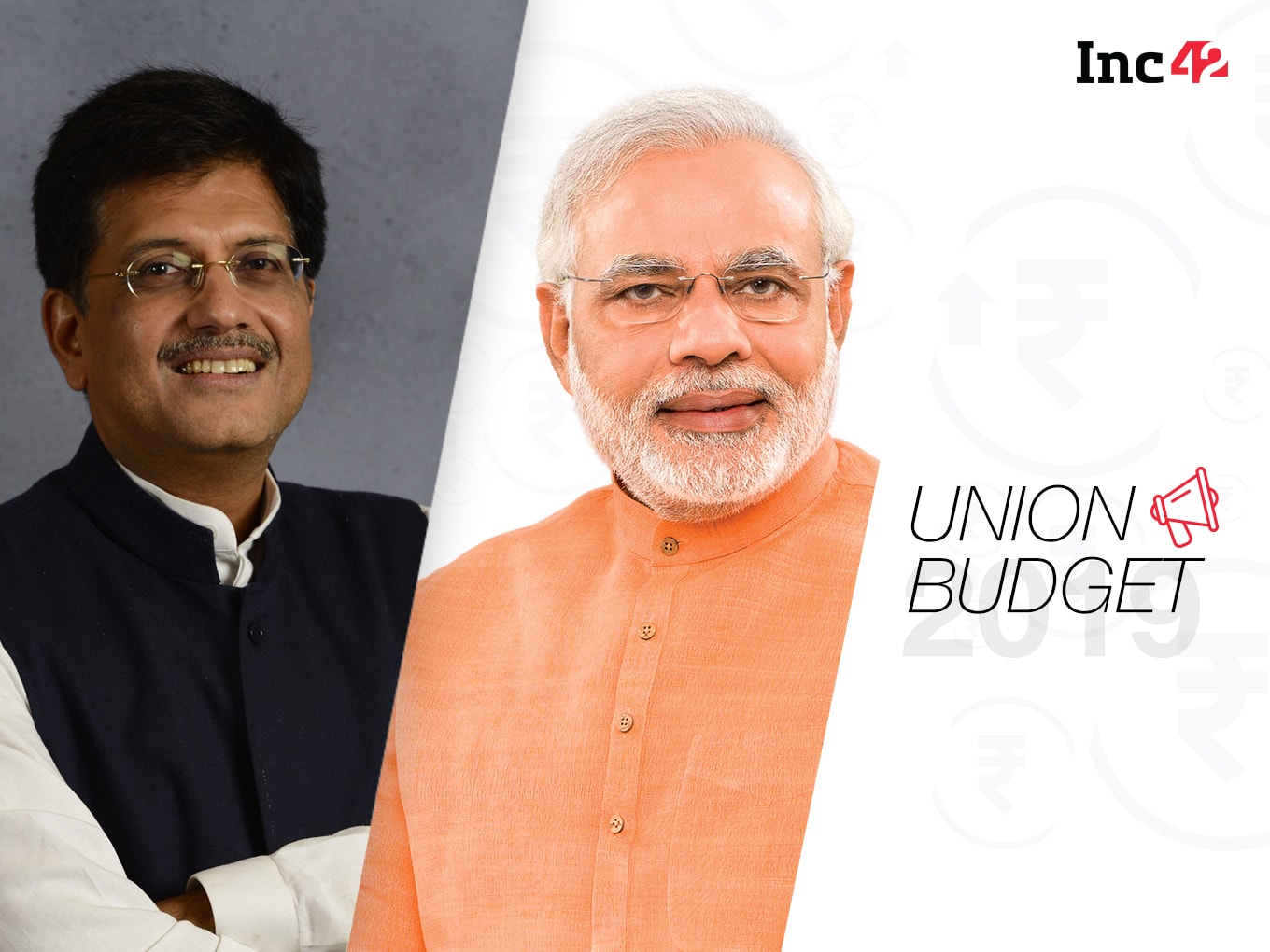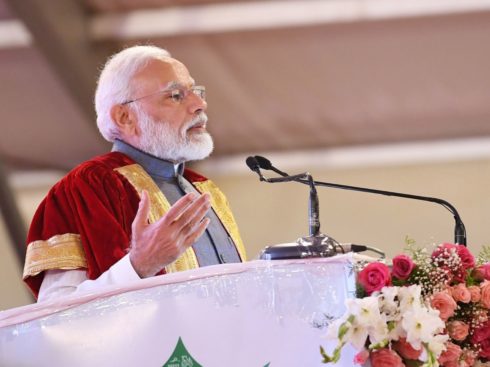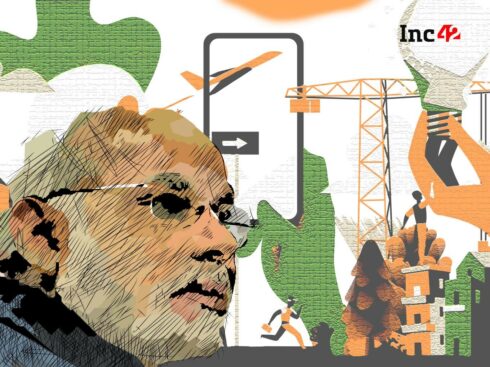SUMMARY
Increased liquidity among the middle class, thanks to the tax rebate, is expected to boost ecommerce, consumer startups
Can startups expect engagement with the government through Ayushman Bharat?
Startups pin some hopes on National AI programme, but how successful will it be without a focus on higher education?
This Interim Budget 2019-20, unlike farmers and middle-class salaried people, startups did not have too many fund-related demands. They had, however, expected the government to address primarily tax-related issues, FDI (in epharmacy), GST issues specifically in edtech and electric vehicles (EVs), and hoped for a better implementation scheme for the Fund of Funds for Startups (FFS).
Ahead of the General Election 2019, interim finance minister Piyush Goyal, while delivering the Budget speech on February 1, missed a huge opportunity to address the core concerns of startups and remove the roadblocks that are hindering the growth of the startup ecosystem in India.
Ramesh Srivats, a media and startup consultant and celebrated satirist on Twitter, in 2013 had defined the budget as “the noble democratic process through which money is transferred from those who work to those who vote.” This is typical of the nature of the Interim Budget in India.
The Interim Budget 2019 is the BJP-led government’s all-out effort to woo the middle class and farmers, both segments that supposedly don’t have a high opinion of government schemes. This is a view inferred from the recent five state elections where the BJP lost in all the five states.
On freebies announced in the Budget, Sanjeev Ahluwalia, advisor to India’s leading think tank ORF, said,
The Modi government is an extremely responsive government. They hit the right buttons, right before the election.
However, the devil lies in the details, and the recently presented Budget, in the garb of an interim Budget, is almost a full-fledged one. A vote-on-account, which merely presents the expenditure to be sanctioned, can’t alter direct taxes. The introduced Budget not only presented the budget estimates for the entire fiscal year but also proposed changes in direct taxes through the Finance Bill 2019.
This is the last budget of the current Modi government.
In a statement shared with Inc42, V Ramakrishnan, CFO of TCS said, “The budget strikes the right balance between progressive initiatives and fiscal prudence, and merits an 8 out of 10. The Interim Budget is focused on providing relief to large sections of the rural economy and on job creation. Additionally, the tweaking of the direct tax code will lessen the tax burden on the middle classes and spur consumption that should benefit multiple sectors, and drive growth.”
We, at Inc42, looked into the Interim Budget in detail, analysing it threadbare from the perspective of the Indian startup ecosystem, while keeping an eye on the overall performance of the government.
Here’s the lowdown:
- Increasing Unemployment, Declining Manufacturing Could Haunt Startups
- Income Tax Rebate To Benefit Ecommerce, Consumer Startups
- Defence Budget: No Defence Innovation Fund Yet
- Does The Budget 2019 Focus On Agritech?
- Skill India: Done And Dusted?
- Why Digital Village Mission Seems Mission Impossible
- The National AI Programme: Will It Take Off?
- Ayushman Bharat: Future Engagement With Startups?
- Did The Budget Address The Core Demands Of Startups?
Increasing Unemployment, Declining Manufacturing Could Haunt Startups
The Budget not only disappointed Indian startups by not entertaining most of their demands but also failed to address the elephant in the room — unemployment and the rising challenges in the manufacturing sector.
While the government’s own data from the National Sample Survey Office (NSSO) showed that the unemployment rate in the country is the highest in the last 45 years, investments in new projects have declined to the lowest levels since mid-2004; stalled projects, too, are at record levels.
This will have repercussions for startups as well. One of the biggest reasons behind failed Indian startups has been getting right skill set and retaining talent. While most corporates have resources to hire and provide training to new hires, startups do not have this luxury of money and time.
Meanwhile,
the declining trend of investments in new projects shows that investors are wary of the Indian market and going for mostly tried and tested projects.
Coming to the manufacturing sector — the mother of all sectors — any downturn in it is bound to create a ripple effect in all the sectors and, thereby, on the GDP. On the other hand, even a 1% increase in the manufacturing sector can have multi-percent increment on the GDP, as it positively impacts almost each and every sector as well as startups.
In 2018, India’s manufacturing sector reportedly performed better than in 2017. However, the Budget 2019 did not factor in anything to up this momentum.
On paper, the Modi government’s flagship ‘Make In India’ programme aims to increase the share of the manufacturing sector in India’s GDP to 25% and create 100 Mn additional jobs in manufacturing by 2022.
Despite Make In India’s ambitious targets and commerce and industry minister Suresh Prabhu’s assurances that the manufacturing sector’s contribution to the GDP will soon hit 20%, the fact of the matter is that its contribution has largely been on the downslide — from 17.39% in 2006 to 15% in 2017-end.
Nobel Laureate (economics) Paul Krugman, who visited India last year, said, “In Asia, India could take the lead but only if it also develops its manufacturing sector, not only the services one.”
How the manufacturing sector can help Indian startups, in the long run, can be understood by observing the China equation. Besides the Chinese government support, one of biggest reasons behind the success of the Chinese startup ecosystem (as well as the Israeli startup ecosystem) is their successful manufacturing sector. Today, the leading Chinese ecommerce company Alibaba is able to supply the cheapest products to over 184 countries because of the strong Chinese manufacturing sector.
Further, it’s the manufacturing sector which is the fountainhead of the innovation ecosystem. US-based leading think tank Brookings Institution in its policy-related framework research marked that manufacturing provides not only high-wage jobs but it is also the major source of commercial innovation and is essential for innovation in the service sector.
“India’s lack in the manufacturing sector could work against it, as it doesn’t have the jobs essential to sustain the projected growth in demography. You have to find jobs for people,” Krugman said.
But, to the contrary,
11 Mn jobs were lost in 2018, says the Centre for Monitoring Indian Economy (CMIE) data. The data suggests that the overall unemployment rate has increased sharply from 6.6% in November 2018 to 7.8% in January 2019.
According to an IndiaSpend report, while jobs have increased at a rate of 0.6%, the unemployment of youth with higher education grew at the rate of 16%, showing that they have been the worst hit.
Thus, the Budget should have prioritised the failing Skill India programme (which we will discuss in detail), increased unemployment, and the ailing manufacturing sector. However, it missed addressing all these problems.
To the Modi government’s credit, however, is the better track record of inflation and fiscal deficit. It has maintained the fiscal deficit below 3.5 as well as the inflation rate — which once used to be in double digits — at a historic low of 2.19%.
The Budget 2019 has a revised fiscal deficit target of 3.4% (of the GDP), 0.1% higher than that of 2018 target.
Interim Budget 2019: Outlay
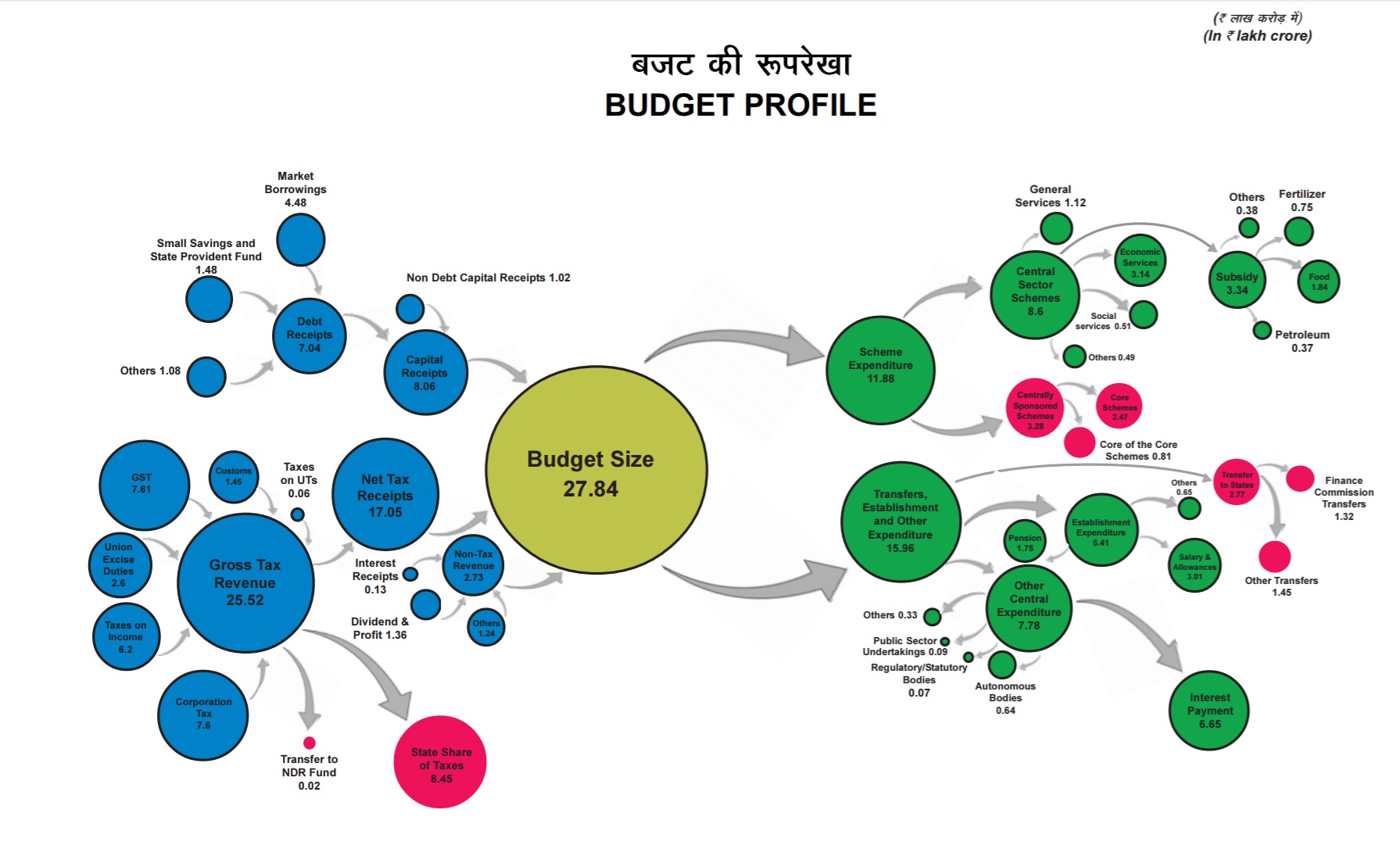
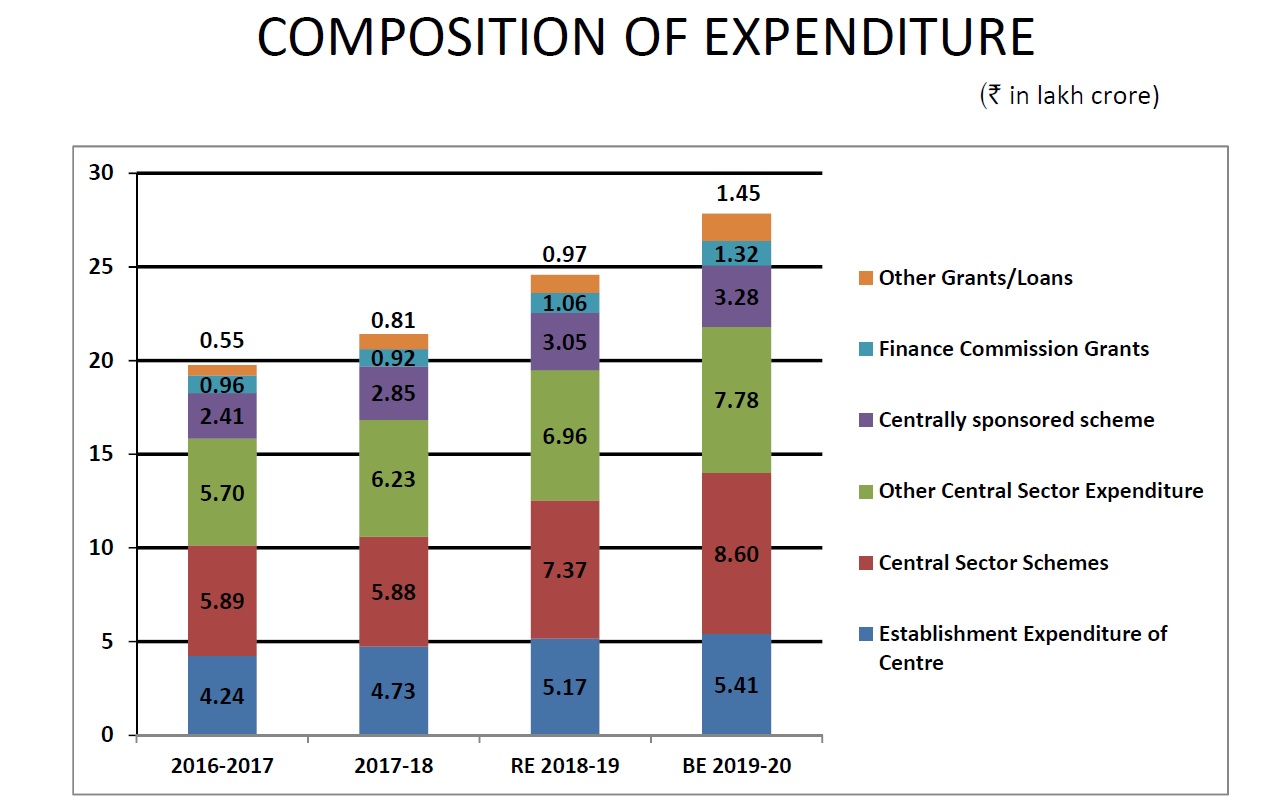
Courtesy: IndiaBudget
The government has made some big announcements for the middle class as well as farmers. With Swiggy, Ola, Flipkart, Dunzo, Zomato, UrbanClap, etc, fast becoming an integral part of the Indian middle-class life and agritech startups enroute to changing India’s traditional farming sector, benefits offered to farmers and the middle class are definitely good news for startups as well.
Income Tax Rebate To Benefit Ecommerce, Consumer Startups
The biggest announcement this Budget was the full tax rebate extended to the INR 2.5-5 Lakh annual income class. While this will cost the government around INR 18,500 Cr, the initiative will directly benefit 3 Cr people.
In a rare move, while thanking taxpayers, Goyal, a chartered accountant by degree, also said that if one takes full benefits of Section 80C of the I-T Act, one would not need to pay any taxes even if their annual earning is up to INR 6.5 Lakh.
Finance minister Arun Jaitley, who is currently in New York for medical treatment, told ANI that this will boost the morale of the middle class. He said, “In 2005, we had 18% middle class, in 2015 it was 29%, in 2025, it is projected to be 44%, so, within a generation, we will a large population graduating into the middle class. Further, the purchasing power of the middle class has increased.”
This rise in purchasing power will directly/indirectly benefit digital/online startups as well, especially fintech, ecommerce, various hyperlocal emarketplaces, and healthtech startups.
As reported by Inc42 earlier, the tax rebate for those with up to INR 5 Lakh annual income was one of the top demands of fintech startups.
The Indian economy has been facing a liquidity crunch due to banking and NBFC frauds and scams such as the Punjab National Bank, ICICI Bank, and IL&FS crisis for the last few months. These scams exposed NBFCs and other fintech companies’ insecurities as well as the lack of separate regulatory boards. The Reserve Bank of India (RBI) recently took a slew of measures in this regard, cancelling as many 31 NBFCs’ licenses as part of the anti-money laundering measures.
Currently, there are over 12,000 NBFCs registered in India.
On one hand, the Supreme Court’s ban on Aadhaar-based eKYC (now amended for banking and telecom) made the entire KYC process costlier. On the other, NBFCs have been facing a tight liquidity crisis, too, since the IL&FS fiasco.
Therefore, increasing creditworthiness and liquidity in the market were the primary demands of fintech startups.
BJP MP Dr Subramanian Swamy, who’s an economist and former Harvard University professor, has been advocating dropping of income tax for the common man. While welcoming the budget and the move, he said, “It is an unstructured collection of making people happy announcements.”
Defence Budget: No Defence Innovation Fund Yet
The defence sector has been allocated INR 3.18 Lakh Cr against last year’s revised estimate of INR 2.98 Lakh Cr. Boasting about the move, Goyal said it’s the first time that over INR 3 Lakh Crore has been allocated to defence. However, factoring in inflation and currency fluctuation, the defence budget actually shows a decline.
In terms of GDP, the defence budget, at 1.51% of the GDP, is the lowest in the last 50 years, since the Indo-China 1962 War.
However, the Budget provided a gateway — by making certain exclusions for startups in the tendering process — for startups to enter the Indian defence sector. Tonbo Imaging is the first defence startup having won a contract from the Indian defence forces.
Last year in August, the defence ministry had launched the Defence Startup India Challenge, inviting startups to engage with defence related projects. However, the project is running behind the schedule and startups are not happy with the prize money allocated under the programme. Some of the startups who have participated in the programme said on the condition of anonymity, the challenge, being very challenging and demanding is not profitable at all.
In the last two years, the defence minister also launched a number of initiatives to support startups working in defence areas and increase their engagement with the Indian forces, with the overall objective of making India self-reliant when it comes to meeting its national defence requirements.
In 2017, the Modi government had also announced plans to form a Defence Innovation Fund to help defence startups. However, on December 26, 2018 Dr Subhash Bhamre, minister of state for defence, informed the Lok Sabha that the Fund is not been formed yet.
While startups were expecting updates on the Defence Innovation Fund this Budget, the startups participating in the Defence India Startup Challenge were also expecting the government to double the prize money from the existing INR 1.5 Cr to INR 3 Cr.
The government has meanwhile, also announced the Defence India Startup Challenge II, while the 1st is still in the progress.
Does The Budget 2019 Focus On Agritech?
Addressing the 12 Cr poor farmers of the country, Goyal announced the Pradhan Mantri Kisan Samman Nidhi (PM-KISAN) scheme which will provide INR 6,000 per year per farmer (to be paid in three instalments) as income support to small and marginal farmers having less than two hectares of land. In a clear election gimmick, he also announced that the scheme would be implemented retrospectively from December 2018 and the first instalment would be disbursed within two months.
Besides, under the Kisan Credit Card (KCC) scheme, a benefit of 2% interest subvention has been extended to farmers pursuing animal husbandry and fisheries. In case of timely repayment of the loan, they will get an additional 3% interest subvention.
The PM KISAN, as well as KCC scheme, aim to increase the liquidity of farmers and will not only help reduce farmer suicides in the country but also serve the Centre’s aim to create farm-prenuers.
Goyal also announced plans to launch a national programme on artificial intelligence (AI) identifying nine priority areas. A National Artificial Intelligence portal will also be developed soon. Agriculture or agritech is one of the nine priority areas of the AI programme. This bodes well for agritech startups, who don’t have access to organised data for ML and AI application as fintech, ecommerce, and healthtech startups do.
The National AI programme will be launched based on the discussion paper for the National Strategy on AI prepared by NITI Aayog, released last year.
According to the report, AI holds the promise of driving a food revolution and meeting the increased demand for food (globally, we need to produce 50% more food and cater to an additional 2 Bn people by 2050 as compared to today).
According to Inc42 DataLabs, in 2016, 50 Indian agritech startups raised $313 Mn. For the first time, this sector saw widespread participation by startups. Intello Labs which uses image-recognition software to monitor crops and predict farm yields, Aibono which uses agri-data science and AI to provide solutions to stabilise crop yields are some of the agritech AI startups.
The launch of the National AI programme is definitely an encouraging step and can boost the potential contribution of agritech startups in India’s agriculture.
Skill India: Done And Dusted?
Speaking about the ongoing skill development programmes, Goyal, in his Budget speech, said that the Aspirational Districts Programme is providing targeted development to the 115 most backward districts of the country. He added that the programme has achieved notable results with improved performance on all indicators — health and nutrition, education, agriculture and water resources, financial inclusion, and skill development.
Since the launch of Startup India in 2016, despite all the hullabaloo about reskilling India, there hasn’t been much focus on Skill India, India’s largest skills training and certification programme.
Speaking to Inc42, a number of edtech startups said that there is an increased to reskill India to improve employability.
According to IndiaSpend Factcheck, with less than two years for Skill India’s deadline in 2020, the government has placed just 1 Mn trainees in jobs — 90% short of the 10 Mn target. Enrolment is short by 64% and certification by 74%. Besides, the actual spending has been far less than what was allocated to the programme.
As per a report entitled ‘Young India and Work: A Survey of Youth Aspirations’ released by World Economic Forum in October 2018, 66% of male respondents and 79% of female respondents reported being unaware of government-run skills development programmes.
The Skill India programme has so far been implemented in correlation with various ministries and their related institutions. However, human resource (HR) tech and edtech startups that provide training and placement services or act as an e-marketplace for the same have been demanding that the Skill India Mission must be implemented in PPP. This will not only improve the employability quotient of Indian youth but could also help them get better placement offers.
Why Digital Village Mission Seems Mission Impossible
Speaking at the Parliament, Goyal also announced that the government will transform 1 Lakh Indian villages into digital villages over the next five years.
While the announcement was welcomed by all, especially tech startups, does it stand any ground?
As of now, it appears to be simply yet another election gimmick as it depends on the next government (whoever comes to power) to take it further. Assuming even if the BJP government comes back to power, will it be able to execute this mission?
The Common Service Centers (CSCs), under the Ministry of IT and Electronics, is still in the process of setting up 700 digital villages, or digi gaons which was supposed to be completed by 2018.
Let’s take cues from another ambitious project of the government — 100 smart cities by 2022. Launched in 2015, the Smart Cities Mission is supposed to transform 100 cities into “smart cities” by 2022 in terms of ICT, supply chain, housing, waste, wastewater management, and mobility infrastructure.
The Centre has approved a fund of INR 98,000 Cr ($14 Bn) and aims to attract INR 8.58 Lakh Cr ($120 Bn) from private players. While dozens of tech startups have been working on the project, if it is executed properly, it was to open up loads of opportunities for IoT, cybersecurity, robotics, WTE, ICT, AI, ML, real estate, and other tech startups.
However, it’s been four years since the announcement, and not a single city has been announced as a smart city.
Minister of state of the Ministry of Housing and Urban Affairs Hardeep Singh Puri said that the proposed timeline for completion of Smart City Mission is:
- Round 1 cities: 2020-21
- Round 2 cities: 2021-22
- Round 3 cities: 2021-22
- Round 4 cities: 2022-23
On the current status of the project, housing and urban development minister Janardan Sigriwal, on January 1, 2019, informed the Lok Sabha that the government has so far allotted INR 16,604 Cr — roughly a third of the promised outlay of INR 48,000 Cr. Of this, only INR 3,560 Cr — 7% of the outlay — has been utilised so far.
However, according to an IndiaSpend report, no more than 1.8% of the funds released for the Mission has been utilised since its launch.
Hence, it doesn’t look like the Smart Cities Mission will be completed within the given timeline. We can well imagine the fate of the new Digital Village mission.
The National AI Programme: Will It Take Off?
Krugman also said that with the rise of AI, India might lose its international relevance in the services sector, hence, it must do its homework to strengthen the manufacturing sector.
To stay in the AI race and, thus, in manufacturing, Goyal, in an undisputedly welcome move, announced plans to launch the National Programme on Artificial Intelligence.
He said that nine priority areas have been identified in which Centres of Excellence (CoEs) will be established and a National Artificial Intelligence portal will also be developed soon. Healthcare, education, agriculture, smart cities, and smart mobility are among the identified priorities areas for the national AI programme.
While this will surely boost startups working in these spaces, will the CoEs be effective if higher education is not kept an area of focus?
As mentioned earlier, funding for higher education as well as agricultural universities and research institutes has declined in this budget. CoEs are usually established at best-in-class institutes such as IITs, IIMs, and AIIMs. However, such institutes, for the past few years, have been struggling to maintain their standards with thousands of teaching posts lying vacant.
Many well-known personalities such as Nobel Laureate Amartya Sen who was the vice-chancellor at Nalanda University; nuclear scientist Anil Kakodkar — the man behind Pokharan who was the chairman of Board of Council at IITB; and IITD director Raghunath Kashinath Shevgaonkar resigned from their positions citing differences with former HRD minister Smriti Irani.
The government, while badly failing to maintain the legacy of such institutes, has announced the setting up of 14 new AIIMS, 6 IITs, and 7 IIMs. The IITs and AIIMS built after 2000 have 60% faculty members’ positions lying vacant.
The aim of establishing the IITs, IIMs, and AIIMS was to provide the best quality education to Indians. However, the government’s focus on expanding their numbers, along with the declining funding for R&D, has brought down the quality of these institutes. Until higher education is prioritised, the national AI programme can’t achieve its full potential.
Ayushman Bharat: Future Engagement With Startups?
The Budget put aside INR 6,400 Cr for Ayushman Bharat — the world’s largest healthcare insurance programme — which aims to cover 50 Cr of the Indian population.
Terming a “healthy India” as the ninth dimension of the government’s vision, Goyal said, “Our government has rolled out the Ayushman Bharat scheme. By 2030, we will work towards distress-free healthcare and a functional and comprehensive wellness system for all. Such a healthy India built with the participation of women having equal rights and concern for their safety and empowerment.”
Welcoming the move, Vishal Gondal, CEO and founder GOQii said, “Ayushmann Bharat’s vision of improving the lives of 50 Cr Indians — which will potentially result in cumulative savings of INR 3,000 Cr by the poor — is a testimony that the Indian government is strengthening the nation’s health ground up. We support the same philosophy that is making healthcare easily accessible to all Indians and the government’s efforts are evident through an increased focus on making medicines, healthcare services, and other health-related instruments more affordable.”
The scheme, in future, might see increased collaboration between the government and startups to help bridge infrastructural requirements.
Did The Budget Address The Core Demands Of Startups?
Apart from the national AI programme and the tax rebate for the middle class (which will boost the buying power of consumers), what does the Interim Budget offer to the Indian startup ecosystem? Not much, given the fact that the Budget did not address the core concerns of startups.
Angel Tax: Not A Word On The Issue
According to Inc42’s Budget Survey 2019, 25% of the startups and investors had demanded that the finance minister address the angel tax issue, which has severely hit angel investments in India over the last few years.
The angel tax issue is entirely the subject matter of the Department of Revenue, which comes under the Ministry of Finance, and the interim finance minister was expected to address the same in his Budget speech. However, there wasn’t any mention of angel tax in the Budget.
Here, it’s worth noting that the Department for Promotion of Industry and Internal Trade (DPIIT) (previously the Department of Industrial Policy and Promotion) organised a roundtable conference on February 4 to listen to the angel tax concerns of startups.
However, the consultation between startup ecosystem stakeholders and the DPIIT has been going on for the past couple of years. Even after the roundtable, in the absence of legislative reform, the issue is unlikely to be resolved.
Fund of Funds Allocation And Implementation
Goyal, while touting India’s startup ecosystem as the second largest in the world in his Budget speech, reduced the funds allocated to the Startup India programme from INR 28 Cr to INR 25 Cr.
Under the FFS, which is part of the Startup India programme, only 163 startups have been funded (December 31, 2018).
For startups, it wasn’t just a matter of getting funding but the way the scheme is being implemented. Currently, the Fund of Funds for Startups is disbursed through the Centre’s Small Industries Development Bank of India (SIDBI), which invites applications from alternative investment funds (AIFs), which in turn invest in DPIIT-recognised startups.
However, out of 350+ SEBI-recognised AIFs, only 35 have been successful in raising funding under the FFS. As many as 12 AIFs of these 35, despite having raised funding under the FFS, haven’t invested in a single startup.
The startups were expecting the government to amend the route so it would be easier for them to raise funding under FFS.
No Tax Exemption Period Extension For Startups
Currently, the Centre provides a tax holiday to startups for the first three years under Section 80-IAC of the Income Tax Act. However, considering India’s inadequate infrastructure, startups have been demanding the tax holiday be extended to at least 5 years.
The demand has not been entertained in the budget.
What does the Startup India report card in the Budget implementation 2018-19 say?
The report card of the Startup India programme 2018-19 states that the agenda for reforming the tax and regulatory structure of venture capital funds, startups, and the AIF framework in India was examined in consultation with the Indian Private Equity and Venture Capital Association (IVCA) and concerned agencies/departments and has been circulated among the respective departments for appropriate action.
So far, the following steps have been taken regarding exemptions in ‘SEBI’s AIF Regulations, 2012’:
- SEBI, vide notification dated June 1, 2018, increased the maximum investment limit by angel funds in venture capital undertakings to INR 10 Cr from INR 5 Cr.
- It enhanced the limit of overseas investment by AIFs and VC funds to $1250 from $500.
- SEBI, in consultation with market participants, issued the ‘Operating Guidelines for Alternative Investment Funds in IFSC’ on November 26, 2018.
- The SEBI Board has approved revamping the Institutional Trading Platform as ‘Innovators Growth Platform.’
Not happy with the Budget, the IVCA reiterated that its primary demand from the government in the full Budget is GST exemption (or reduction to 5%) on management services and other expenses incurred by AIFs managed by India-domiciled asset managers. “This move will ensure more offshore funds to onshore in India and will boost overall Indian Investments via the PE/VC route and generate more employment in India,” said the IVCA.
The IVCA also demanded clarity on the applicability of capital gains tax and exemptions for investors. Further, it highlighted its recommendations on angel tax, seeking safeguard for startups from Section 56(2) (viib) and from Section 68 of the Income Tax Act 1961.
“We hope to get a resolution on this irrespective of the budget. The association and the ecosystem are hopeful that its demands will be picked up in the upcoming Finance Bill post the General Election,” the IVCA added.
Is Startup India A Flagship Project? The Budget Does Not Reflect So
While some states — Kerala, Andhra Pradesh, Goa and Rajasthan — had already released startup oriented policies, India’s startup ecosystem got a push only after the Modi government announced its Startup India policy in 2016. The policy brought in a series of measures such as recognising business as startups, minimising norms, the formation of incubation centres, tax exemption under Section 80-IAC, and more.
With not a single flagship project running on schedule, the interim finance minister, in an unusual move, made a series of new announcements, which appeared to be an attempted cover-up of the government’s failure in implementing these schemes.
Further, barring few projects like Smart Cities, the Budget estimates for the major flagship schemes have either been reduced or not mentioned in the outlay.
This includes Startup India, Skill India, Clean Ganga, Clean India, and many other projects. The Budget has clearly shifted attention away from the very core projects the government wanted to encash on. While the DPIIT and the CBDT are still looking into the angel tax exemption issue, here are the other demands and problems that startups wanted the Interim Budget to address:
- Creation of a Medical Innovation fund to support medtech and epharma startups
- Creation of a Defence Innovation Fund to support defence startups
- Reduction in GST from 18% to 5% for edtech startups
- Reduction in GST on EV components
- Extension of Section 80-IAC beyond the current three years
- Automation of the route to Section 80-IAC as well as angel tax exemption
- FDI in epharma like ecommerce
- A tax breather (deferring TCS) should be given to ecommerce companies
- The Government eMarketplace (GeM) should be more open and incorporative for startups
- Simplification of TDS, repayments in online lending
- Reskill India to improve employability
- Introduce an epharma policy
The top demands which were met are:
- The tax rebate to the middle class in the INR 2.5 Lakh to INR 5 Lakh income category, which will bring liquidity back in the market
- Reduction in import duty on EV components
- National AI Programme and the creation of an AI portal
Clearly, the Modi government hasn’t given apt attention to its pet project Startup India, which it often brags about. The PM has even said he hopes that startups will be the backbone of employment in India.
Of course, the reforms have been slower than what the Indian startup ecosystem had expected from the Modi government. However, with a host policy initiatives and more drafts in process, by and large, it has been on the track.
And, the reforms must continue and should remain on track, irrespective of the results of General Election 2019.



